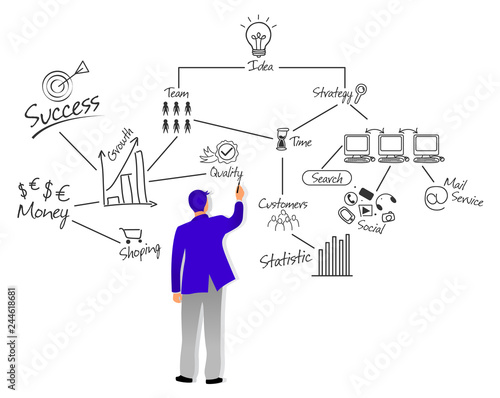A story about a startup business strategy in action
I’ve launched a new AR focused startup. Regarding the headline, it is very misleading. I haven’t actually earned a single penny of sales revenue yet. However, I did have an (almost) million-dollar month of sorts. I have just started to execute my business strategy and tactics and they are playing out (generally) as I intended. Market conditions are developing as I predicted, faster even, and I’m getting excited. This story is about launching a startup.
Things are not happening exactly as I planned. They obviously never do. It’s just that the surprises are, well, surprising. Some things have taken longer, and some things are happening way faster than I could have imagined.
AR Obsession
As I’ve mentioned in a previous article, I became obsessed with AR many years ago. At the time, I was a software product owner in a major global corporation, it was my job to watch trends and propose and deliver cutting edge solutions. However, I just couldn’t get any traction with my AR vision, we just had too much other backlog to head off in a new direction. I then tried getting hired into companies with potential or intention to get into AR, but I just couldn’t land a gig.
My obsession was real, so I needed to find some way to feed it. I decided I just needed to start my own company but how the heck would I get started? How could I fund it? I decided to leverage my side hustle in real-estate to flow some capital into my coffers to get me started.
One Strategy Point
I am bootstrapping (self-funding) at first. I want to maximize my pre-money valuation before I look for investment funding. I will try to fund this on my own up until I have some early (paying) customers. When I do look for an initial capital influx, I want to be able to get enough to really build the business while keeping a decent share of the equity for me and my fellow founders.
All In
I quit my high-tech, high-pay job. Well, it took three tries, but I finally did and went all in on my real estate scheme. I planned to take 6-9 months to do a few small flips and fixup and sell off my rentals. Then I could tackle the big flip, a 120-year-old 3,000 sq ft Victorian I already owned. It was decaying and decrepit, but I only paid $215k for it and it could be worth $750k if done right.
Not everything goes to plan. My first flip took 9 months, while I was still working my last corporate job. The cash ROI on that project was zero. I got my money back but that was it. The rentals did sell at decent prices so I could still launch the mega project.
I lived in the attic of the decrepit Victorian for 18 months while I went downstairs everyday and rebuilt the entire building. Oh yeah, I simultaneously had an offshore team and a few free lancers around the globe building prototypes of my AR platform, so I’d be able to hit the road running once I cashed in on the Victorian. Staying focused on my obsession fueled my daily work.

When I was nearly finished with the massive flip, the market in my area was smoking hot, properties in my price range were selling in 3 days with multiple offers. Things were looking pretty good. My place came out amazing and my realtor pegged my sale price at $884k. That is $130k over my original expectation. Oh yeah. I was completely burned out, nearly busted and so happy to finally be ready to sell this baby.
I listed the home (in June 2021) one week after covid restrictions were lifted in California and the buyers disappeared. Properties just stopped selling. Fast forward 90 days and I had only seen 5 buyers come and look at the home. No sale.
During those lonely 90 days I really felt the letdown, having expected the property to sell in a few days for over asking. I kept telling myself that God didn’t teach me how to swim, just to let me drown but I sure felt like I was going under. I had some severe self-doubt about my craftsmanship and my price expectations. Everyone was telling me what beautiful job I had done but hardly any potential buyers were looking. I really was all-in and needed an out. I had done my homework; I had managed my risk and could hold the property for the next year if I had too. I learned some good lessons there and a little bit about patience too.
Finally, the right buyer showed up and 120 days after I listed, I closed an all-cash offer for $875k.
Another Strategy Point
I’ve written before about my belief that AR will deliver a huge wave of business and specifically when AR glasses sufficient for my intended workflows are moving towards mass market acceptance. My explicit strategy is to build a viable AR business now (in the Visual Search segment) using mobile devices (phones/tablets) as the client, with the full intention that once the market swell caused by viable glasses happens, I’ll be a very attractive investment for the smart money looking to be in AR.
Such a Spectacle
 We are seeing so much activity in the “AR” glasses game. Yes, many of the “AR” glasses or “Smart Glasses” are just camera glasses or audio glasses or HUDs. However, having been fortunate enough to be accepted into the Snap Next Generation Spectacles (4) beta program, I can say the new Spectacles are truly AR glasses. I would have to re-read my NDA to know what else I can say so I’ll just leave it at that. There are some other great solutions as well.
We are seeing so much activity in the “AR” glasses game. Yes, many of the “AR” glasses or “Smart Glasses” are just camera glasses or audio glasses or HUDs. However, having been fortunate enough to be accepted into the Snap Next Generation Spectacles (4) beta program, I can say the new Spectacles are truly AR glasses. I would have to re-read my NDA to know what else I can say so I’ll just leave it at that. There are some other great solutions as well.
Having had my Snap awareness raised, I learned that Snap had funded a Ghost Fellowship grant program and I applied. I was seeking $125k to build out an amazing solution on the Spectacles platform. I made the first cut, got an interview and it went great with a great engaging team. I was really looking to push the tech farther than it can go at this time, but they got it, asked all the right questions, hard questions, and seemed enthusiastic. I evaluated the situation and felt I might have slightly better than even odds getting accepted.
I was so stoked. This extra $125k was not in my original plan at all. However, I had predicted that as AR started gain traction, gaining some attention, the money would start to flow into this segment. I was thinking maybe late 2022 when Apple ships their AR glasses. Now, in just the last months we have seen many of the big players and lots of upstarts making announcements about glasses, shipping products. We are even seeing the traditional early placeholder products from big players just so they can have a presence in the market while they play catch up. Heck, Snap has created a $3.5M grant fund to accelerate their platform. That’s just straight up cash on the barrel. Money was coming into this market.
I didn’t get the grant.
That would have made my million-dollar month. $875k + $125k. I let it get me down for about a minute and then I started concentrating on building my resolve. I’ll have a lot of these lost opportunities. I’ll need to experience a lot of lost opportunities to accumulate a few wins along the way.
Focus, Bill
What does an engineer do when the machine he is designing fails? Of course, they analyze the failure. They go back and review the relevant design principles, prior art, the acquired knowledge base of their education and experience. Break the problem down into its numbers, into measurable, smaller components that can each be analyzed, optimized, swapped out.

My machine is a business. So, what things do I know about such a business? For me, there are several software business “Truths” I have garnered from my education and building businesses inside corporations, grinding out in various startups, my own little ventures and learning from my friends and colleagues, from my failures and successes.
- One magic number seems to be the $40M year.
- If you can generate $10M a quarter, you are legit.
- You won’t see an IPO without seeing that number first
- That is a lot of fricking business for a guy with a prototype and “no customers — at all
- In the software business, I think the standard target is to generate $200-$250k per employee, per year.
- Let’s see, Google says Autodesk does $3.79B.
- 1,500 employees
- That is $330k per. Nice work Andrew.
Okay, I have a few first principles I can work with, but my design, my business plan, is a bit hard to write as a $40M business when I haven’t made my first dollar yet. However, I was generally comfortable with that “million-dollar month” concept.
The Million-Dollar Month
Ok, I can start to back into some numbers, mathematically. $12M a year divided by $250k per employee pencils out to 48 employees. That is a number I can envision. I only ever managed less than half that many people directly but, in a matrixed org as a product owner, I orchestrated the actions of many times that many people, in many different roles, taking my product to market. I never had CEO as my title so with that little extra kick-ass, my-word-is-law authority, I think I can do that.
Now when we are saying $250k per employee, we are not talking about 48 engineers. That headcount includes the lowly office boy, HR, PR, purchasing, sales, etc. So, as I envision growing an org from zero, the plan needs to be accountable for that total structure.
Backing into some more numbers, if I am targeting enterprise customers, then $1M a month means some distribution like 100 customers paying $10,000 each per month or 1,000 customers paying $1,000 per month. That starts to indicate a rather large sales org. Math again, each individual customer is at $12k-$120k per year. I think a sales guy might be able to find and manage maybe 10 customers that size. Therefore, I’ll need 10 fully loaded sales guys to deliver that revenue. Honestly, it’s probably more like 20 sales guys. That won’t fly. I can’t have nearly 50% of my org as sales guys if I am also building products.
My enterprise market experience has always included, or even been exclusively an indirect sales channel. Resellers. The cliché’s here are endless. An indirect sales channel is the worst type of sales channel, except for every other type of channel. Motivating resellers is like pushing rope. It’s not an 80:20 rule with resellers, 1 out of 10 resellers will deliver most of your sales. Unfortunately, these are not just cliché’s, I find them to be among the “truths” I spoke of earlier.
Even so, I never met a reseller I didn’t love. Honestly, these are the guys on the street in every big and little city. How in the heck can I make a sale in Omaha when I am sitting in California? The price of the flight alone kills the idea. If I can have one direct sales employee, reseller manager, who can effectively engage 6 or 8 reseller organizations, I can conceivably have dozens of salespeople on the street for each direct sales employee/manager. That drastically lowers the number of direct sales staff I’ll need. Yes, there are all levels of competence and enthusiasm in the reseller channel. However, if you can deliver the value to deserve the attention of a reseller, you can get it.
Building the Plan
I have not written much here about a successful product building process. I’ve written before about my approach to product planning and development. For me, that is the easy part. I’ve been a product owner and understand that realm. Now I am expanding my vision to being a business builder.
Strategy point number one is to hold off getting a capital influx until I have some paying customers. There is a long way between today and that waypoint. Therefore, my plan needs to devise a ramp that gets me that far. I won’t have 48 people in my employ while I am in my bootstrap phase. Regardless, I can at least stay focused on what is the critical path between here and those first few paying customers. What product and organization can get me that far?
Strategy point number two is to build a viable AR Visual Search product and business using mobile apps as the client. Then capitalize on the market buzz of AR glasses as they take off. Honestly, even in the time it took to pen this piece I started losing focus on that. The business issues of hiring sales guys, making a monthly target, it all starts to blur the focus. I need to keep a sharp eye on product. A product that can deliver to my target customer.
client. Then capitalize on the market buzz of AR glasses as they take off. Honestly, even in the time it took to pen this piece I started losing focus on that. The business issues of hiring sales guys, making a monthly target, it all starts to blur the focus. I need to keep a sharp eye on product. A product that can deliver to my target customer.
Organizing my thoughts for this piece has helped me sharpen my “Next Steps” focus. It also reaffirms to me I’ve been generally doing the right things so far.
In Action
LinkedIn has been a fantastic platform from which I can network and start to build out legitimate valuable relationships and move my business forward in this early phase.
Distribution: I have been connecting with distribution partners from my previous positions and finding new ones. Really smart people who are engaged daily with my potential customer base. I have really enjoyed briefing them on my platform and the problems it solves. About half of the engagements are super valuable. Some people have different interests or already have a strong focus elsewhere; or they just don’t get it. Regardless, I have several individuals and orgs ready to learn more and potentially take my product to their base.
Partners: I’ve been connecting with potential technical business partners. Both former colleagues and newly discovered connections. I have lined up some potential innovative integrations and have a shared vison about potential future markets opened by AR and associated spatial/geospatial tech, with some great folks.
Technical Innovation: I’ve also been meeting and having very cool discussions about technical challenges and developments of my AR platform. I feel so fortunate to be able to find and sometimes hire such brilliant folks to solve difficult issues that ultimately will deliver a simple product for my users. I really love being on that leading/bleeding edge and seeing potential and existing technologies come together in a vertical integration to make hard problems seem to have a simple solution.
In Conclusion
I’ll be out here working towards that real million-dollar month. I’ll likely share more about the adventure as things develop. I look forward to meeting new people and building great new things together. I hope you have found some value in my inner thoughts exposed and I am always open to having a candid discussion about the AR business, the startup challenge and stuff like that.
